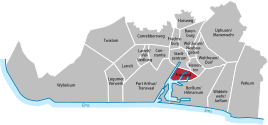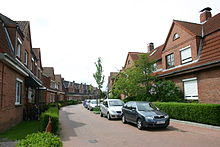Friesland (Emden)
|
Friesland
City of Emden
Coordinates: 53 ° 21 ′ 18 ″ N , 7 ° 13 ′ 18 ″ E
|
|
|---|---|
| Residents : | 828 (Dec. 31, 2010) |
| Postal code : | 26725 |
| Area code : | 04921 |
|
Location of Friesland in the city of Emden
|
|
The Friesland district of Emden , also known as the Friesland colony , is a workers' settlement from the first half of the 20th century. Its original condition has largely been preserved. It was built for the employees of the North Sea Works . Most of the roads are named after North Sea islands. Many of the houses have a small garden in the back yard, which in the past (and partly still today) was used for self-sufficiency by growing fruit and vegetables or by keeping animals. Friesland has 828 inhabitants (as of December 31, 2010).
location
The district is bounded on the northern side by the Rheine – Norddeich Mole railway line and on the eastern side by the Borssumer Canal and the connecting canal, which links the Emden harbor with the Ems-Jade Canal and therefore takes its name. The North Sea Works and other port operations are located in the west of Friesland. The Emden fairway forms the western limit, the industrial port to the south.
history
The first residential buildings in the new working-class district in the then up-and-coming city were completed before the outbreak of the First World War , but the majority of the colony was completed during the Weimar Republic .
In the course of the construction of the bunker in the Second World War , a bunker was also built at a central location in the Friesland colony. The building, designed by the Schumacher / Meyer consortium from Leer and Emden, was completed on July 21, 1942. The three-story bunker held 768 people. As with the other bunkers in the Emden city area, foreign foreign and forced laborers were also used in the Conrebbersweg bunker. In Friesland there was a forced labor camp and foreign labor camp for the people who built the bunker.
In the 1960s, the colony was a pure shipyard workers colony. However, the ties to the shipyard dissolved in the following decades. In the 1990s, the houses were sold to residents (or other interested parties) through investors.
politics
The workers 'settlement in Friesland has been a stronghold of the workers' parties since it was founded. During the Weimar Republic, the KPD had one of its strongholds here in Emden, but the SPD also always won a large number of votes. After the Second World War and the ban of the KPD , the SPD took on the leading role in the district.
Like all of East Friesland - and Emden in particular - the district has been a stronghold of the SPD for decades.
In the federal elections in 2002 , the SPD achieved the best result nationwide: it received 85.2 percent of the second votes in the constituency of 320 (Emden-Friesland), while the SPD direct candidate Jann-Peter Janssen won 85.7 percent of the first votes. In that election, only the CDU made it over the five percent hurdle in the district.
In the 2013 federal election , the residents of Friesland confirmed the SPD with a large majority, albeit less clearly than in many previous elections. The SPD got 67.09 percent, the CDU 11.65, the Left 5.18, the Greens 4.92 and the FDP 2.07 percent. For comparison: In the entire urban area, the SPD achieved 48.59, the CDU 25.98, the FDP 3.13, the Greens 9.15 and the Left 6.04 percent. Other parties accounted for 7.04 percent across the city.
Economy and Infrastructure
In addition to the Nordseewerke , which are now active in the offshore wind turbine industry after the shipyard was closed, Emder Werft und Dockbetriebe GmbH continues to exist as a subsidiary of ThyssenKrupp Marine Systems . It deals exclusively with the repair of ships. In the Friesland part of the port there are also building material handling operations such as the Ems-Jade-Mischwerke . The Emden Waterways and Shipping Office operates its building yard ( also known as the "barrel yard" because of the shipping signs stored there ) at the old and new dock. In the residential area of the district there is a residence of the East Frisian Employment and Housing GmbH, a facility for the disabled.
The former Emden marshalling yard is located in the district.
In the 1970s, the southern bypass called the southern bypass of the Emden city center was built in Friesland , which significantly improved the flow of traffic in the seaport city. The bascule bridge over the Emden fairway was completed in 1974, the so-called trough section , a crossing under the port railway tracks in the direction of the south quay with ore handling at the time, began in 1975 and was completed in 1977. In terms of traffic, the district is developed through Landesstraße 2, which runs through Emden in an east-west direction. The federal highway 210 , which leads to the Emden-Ost junction of the federal highway 31 , also begins near the district . While the traffic connection can thus be described as good, the heavy goods traffic in the eastern area of the Emden harbor via the L 2 meets with criticism from the residents. A bypass is therefore being planned.
The bus routes 6 (SVE) and 621 (DB Weser-Ems-Bus) stop in the district on Petkumer Straße.
Sport and club life
The Friesland Citizens 'Association takes care of the residents' concerns and also operates an event room in the district.
literature
- Marianne Claudi, Reinhard Claudi: Golden and other times. Emden, city in East Frisia . Gerhard Verlag, Emden 1982, ISBN 3-88656-003-1 .
- Heinrich Schmidt : Political history of East Frisia. ( East Frisia in the protection of the dike , vol. 5). Verlag Rautenberg, Leer 1975, without ISBN.
- Ernst Siebert, Walter Deeters , Bernard Schröer: History of the city of Emden from 1750 to the present. (East Frisia in the protection of the dike, vol. 7). Verlag Rautenberg, Leer 1980, DNB 203159012 , therein:
- Ernst Siebert: History of the City of Emden from 1750 to 1890. P. 2–197.
- Walter Deeters: History of the City of Emden from 1890 to 1945. P. 198–256.
- Bernard Schröer: History of the city of Emden from 1945 to the present. Pp. 257-488.
- Michael Foedrowitz , Dietrich Janßen: Air raid shelter in Emden. Self-published, Berlin / Emden 2008, OCLC 254736187 .
- Theodor Janssen: Hydrology of East Frisia . Verlag Ostfriesische Landschaft, Aurich 1967, without ISBN.
Web links
Individual evidence
- ^ City of Emden: Statistics Info 01/2011 . S. 40 ( statistics info / online document [PDF]).
- ^ Michael Foedrowitz, Dietrich Janßen: Air raid shelter in Emden . Self-published, Berlin / Emden 2008, without ISBN, p. 50.
- ↑ Dietrich Janßen: Who built the Emden bunker? Concentration camp prisoners, prisoners of war, forced and foreign workers in Emden. In: Stadtarchiv Emden (ed.): They were among us. Foreign and forced laborers in Emden 1933–1945. (Series of publications by the Emden City Archives, Volume 8). Emden 2012, ISBN 978-3-9815109-0-4 , pp. 45–52, here p. 42 ff.
- ↑ Axel Vornbäum: Colony Abendrot , in: Der Tagesspiegel , August 24, 2005, accessed on May 4, 2013.
- ↑ Klaus von Beyme : The political system of the Federal Republic of Germany: An introduction , VS Verlag, Wiesbaden 2004, ISBN 3-531-33426-3 , p. 100, limited preview in the Google book search, accessed on February 28, 2013.
- ↑ Axel Vornbäum: Colony Abendrot , in: Der Tagesspiegel , August 24, 2005, accessed on May 4, 2013.
- ↑ kdo.de: Voting districts Emden , accessed on September 25, 2013.
- ↑ emden-dockyard.com: Homepage , accessed on May 4, 2013.
- ↑ wsv.de: Bauhof Emden , accessed on May 4, 2013.
- ↑ obw-emden.de: Wohnstätten ( memento from October 31, 2013 in the Internet Archive ), accessed on September 8, 2013.
- ^ Bernard Schröer: History of the city of Emden from 1945 to the present. In Ernst Siebert, Walter Deeters, Bernard Schröer: History of the city of Emden from 1750 to the present. (East Frisia in the protection of the dike, vol. 7). Verlag Rautenberg, Leer 1980, DNB 203159012 , pp. 271, 424.


